
by Deep Green Resistance News Service | Jan 10, 2018 | Human Supremacy
Featured image: Real freedom is not found in the quest to escape limits but in deepening our understanding of our place in a world with limits. EATCUTE / GETTY IMAGES
by Robert Jensen
In a routinely delusional world, what is the most dangerous delusion?
Living in the United States, I’m tempted to focus on the delusion that the United States is the greatest nation in the history of the world – a claim repeated robotically by politicians of both parties.
In a mass-consumption capitalist society, there’s the delusion that if we only buy more, newer, better products we all will be happier – a claim repeated endlessly in commercial propaganda (commonly known as advertising and marketing).
I’m also white, and so it’s understandable to worry about the delusion that white people are superior to non-white people. And as a man, I reflect on the delusion that institutionalized male dominance is our fate, whether asserted to be divinely commanded or evolutionarily inevitable.
But all these delusions that rationalize hierarchies within the human family, and the resulting injustices that flow from those hierarchies, are less frightening to me than modern humans’ delusion that we are not bound by the laws of physics and chemistry, that humans can live beyond the biophysical limits of the ecosphere.
This delusion is not limited to one country, one group, or one political party, but rather is the unstated assumption of everyday life in the high-energy/high-technology industrial world. This is the delusion that we are – to borrow from the title of a particularly delusional recent book – the god species.
This ideology of human supremacy leads us to believe that our species’ cleverness allows us to ignore the limits placed on all life forms by the larger living world, of which we are but one component. What we once quaintly called “environmentalism” – which too often focused on technical solutions to discrete problems rather than challenging human arrogance and the quest for endless affluence – is no longer adequate to deal with the multiple, cascading ecological crises that define our era: climate destabilization, species extinction, soil erosion, groundwater depletion, toxic waste accumulation, and on and on.
Playing god got us into this trouble, and more of the same won’t get us out.
This inability to accept the limits that come with being part of “nature” – a strange term when used to contrast with “human,” as if humans were somehow not part of the natural world – was on my mind as I read two new books about controversial topics that typically are thought of as social, not ecological, issues: Transgender Children and Young People: Born in Your Own Body, edited by Heather Brunskell-Evans and Michele Moore, and Surrogacy: A Human Rights Violation, by Renate Klein.
Both books offer a feminist critique of the ideology and practices of these movements that herald medical/technological “solutions” to struggles with gender norms and infertility.
Brunskell-Evans’ and Moore’s book brings together researchers, activists, mental health practitioners and parents who question such practices as puberty suppression to block the development of secondary sex characteristics as treatment for gender dysphoria. Are such disruptions of a child’s development with powerful drugs warranted, given the lack of testing and absence of a clear understanding of the etiology of transgenderism? The authors challenge what has rapidly become the liberal dogma of embracing medicalized approaches to the very real problem of patriarchal gender norms (the demand that boys must act one way and girls another) that constrain our lives.
Klein marshals research and the testimony of surrogates to point out that another liberal dogma – affluent individuals have a right to “rent a womb” so they may have a child genetically related to them – involves considerable risks for the surrogate mother (sometimes referred to as the “gestational carrier”). The author’s assessment is blunt, but well supported: modern surrogacy is a form of exploitation of women and trafficking in babies.
Both books demonstrate the enduring relevance of the radical branch of feminism that highlights men’s attempts to control and exploit women’s reproductive power and sexuality as a key feature of men’s dominance in patriarchal societies. And both are critical of the naive celebration of high-tech medicine to deal with issues that stem from patriarchy’s rigid, repressive and reactionary gender norms.
Those radical feminist challenges dovetail with a radical ecological critique that reminds us that being alive – being a carbon-based creature that exists within the limits of the ecosphere – means that we should be sceptical of claims that we can magically transcend those limits. The high-energy, high-tech, human-defined world in which we live can lull us into believing that we are like gods in our ability to shape the world, and to shape our own bodies.
Of course, drugs, surgery and medical techniques routinely save lives and improve our lives, in ways that are “unnatural” in some sense. To highlight these questions does not mean that lines are easy to draw between what is appropriate and what is ill-advised. But we invite serious miscalculations when we embrace without critical self-reflection the assumption that we can manipulate our human-centred worlds without concern for the limits of the larger living world.
Many of us have experienced this in end-of-life care decisions for ourselves or loved ones. When are high-tech medical interventions that prolong life without concern for quality of life a mistake? I have had long conversations with friends and family about where the line should be drawn, not only to make my own views clear but to search for collective understanding. The fact that the line is hard to draw, and even harder to face when arriving at it, doesn’t make the question any less relevant. The fact that there is no obvious and easy answer doesn’t mean we can avoid the question.
Elective cosmetic surgery is perhaps the best example of the culture’s rejection of limits. All living things eventually die, and human appearance changes as we age, yet many people search for ways to stave off that aging or to change their appearance for other non-medical reasons. In 2017, Americans spent more than $15 billion on cosmetic procedures (surgical and nonsurgical), 91% of which were performed on women. The two most common surgical procedures are liposuction and breast augmentation. Although some people who get liposuction are overweight, it is not a treatment for obesity, and breast augmentation is rarely related to physical health. These procedures typically are chosen by people seeking to conform to social norms about appearance.
With this humility about high-tech human intervention in mind, how should we understand the experience of feeling at odds with gender norms? How should we reconcile the physical inability to bear children with the desire to have children? There are no obvious or easy answers, but I believe that as a culture we are better served by starting with the recognition that we are not gods, that we cannot endlessly manipulate the world without risking unintended consequences for self and others. How does the rejection of limits impede our ability to first examine and then resist the impositions of patriarchy, to find new understandings of sex/gender and new social relationships for caring for children?
At the planetary level, we have considerable evidence that our faux-god attempts to dominate the ecosphere – which started most dramatically with the invention of agriculture 10,000 years ago and intensified with the exploitation of fossil fuels – now make the future of a large-scale human population uncertain. The lesson some of us take from that is to turn away from the “technological fundamentalism” that leads us to see all problems as having high-energy/high-tech solutions and consider different ways of living within the biophysical limits of the planet.
That same perspective is compelling on the level of these questions around gender and fertility. Here’s a sensible place to start: We should step back from the hyper-individualism of neoliberal ideology and examine more deeply how the institutionalized male dominance of patriarchy has shaped our collective thinking about gender and identity, and about women’s status and parenting. Such reflection reveals that the liberal ideology on transgenderism and surrogacy embraces the technological fundamentalism that embraces medical and market “solutions” rather than enhancing the sense of integrity that we seek.
Integrity is a key concept here because of its two meanings – adherence to moral principles and the state of being whole. We strive to act with integrity, and to maintain the integrity of both the living body and the larger living world. In hierarchical systems that reward domination, such as patriarchy, freedom comes to be understood only at the ability to control, others and the world around us. Andrea Dworkin captures this struggle when she writes:
“Being an object – living in the realm of male objectification – is abject submission, an abdication of the freedom and integrity of the body, its privacy, its uniqueness, its worth in and of itself because it is the human body of a human being.”
Freedom in patriarchy is granted only to those in control, and that control turns other living things into objects, destroying the possibility of integrity-as-moral-principles and integrity-as-wholeness. Real freedom is not found in the quest to escape limits but in deepening our understanding of our place in a world with limits.
Robert Jensen is a professor in the School of Journalism at the University of Texas at Austin and the author of The End of Patriarchy: Radical Feminism for Men.
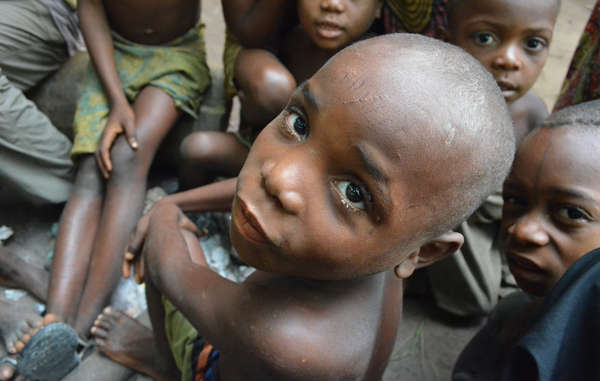
by Deep Green Resistance News Service | Jan 8, 2018 | Colonialism & Conquest
Featured image: A recent epidemic in the Republic of Congo is said to have been aggravated by the loss of indigenous peoples’ resources due to conservation and logging projects. © C. Fornellino Romero/Survival International
by Survival International
A Congolese organization has recently raised concerns that conservation contributed to the deaths of several dozen children, mostly Bayaka “Pygmies,” during an epidemic in 2016 in the Republic of Congo – the latest in a long line of related reports.
The deaths have been attributed by a medical expert to malaria, pneumonia and dysentery, aggravated by severe malnutrition.
Conservation-related malnutrition among Bayaka children in this region has been reported since 2005 at least, as the Bayaka are prevented from hunting and gathering on their lands by wildlife guards through violence and intimidation.
These guards are funded and equipped by the Wildlife Conservation Society (WCS), one of the world’s largest conservation organizations, and the logging company it has partnered with, CIB. Both organizations have failed to take effective action to prevent abuse.
“The wildlife guards abuse us. They don’t want us to go into the forest. How can we feed our children?” a Bayaka man from Mbandza, the site of the epidemic, told Survival in 2016.
These guards have been accused of abusing Bayaka and stealing their food for over 13 years. One such attack that took place in Mbandza in early 2016 left one man hospitalized.
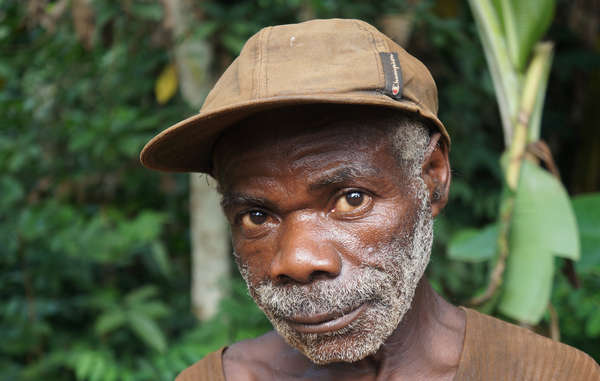
The Baka and Bayaka’s consent is required by law for any major project on their lands, but this is ignored by WWF and WCS. © Survival International
In this way, the Bayaka are being illegally evicted from their ancestral homelands by threat of violence. As one Bayaka woman explained: “If we go into the forest we eat well there compared to the village. We eat wild yams and honey. We want to go into the forest but they forbid us to. It frightens us. It frightens us.”
Critics have noted that the guards have also failed to protect the wildlife the Bayaka depend on for food, since they have difficulty tackling corruption and the creation of logging roads, the two main drivers of poaching.
Plummeting health has been reported among Bayaka living in the Dzanga-Sangha Protected Areas in the Central African Republic – one of the World Wildlife Fund’s (WWF) flagship projects – since 2006. Conditions encountered among older women “would be considered a public health crisis by international health agencies,” according to research published in 2016.
Increased malnutrition and mortality have been reported among Baka “Pygmies” in Cameroon, where WWF also operates, and among Batwa “Pygmies” in another of WCS’s project sites in east Democratic Republic of Congo.
“Now we are afraid of the anti-poaching squads. Before when a woman gave birth we took her to the forest to help her regain her strength and weight, now we can’t do this. We would take our children to the forest to avoid epidemics. Now we know illnesses we never knew before,” one Baka woman in Cameroon told Survival.
Watch Baka describe the abuse they face as a result of WWF’s conservation projects
Baka health plummets due to conservation
In the Congo Basin, the Baka, Bayaka and dozens of other rainforest peoples are being illegally evicted from their ancestral homelands in the name of conservation. Their health is plummeting as a result.
The big conservation organizations that support these conservation projects, like the World Wildlife Fund (WWF), refuse to abide by basic international standards and secure their consent.
Neither WCS nor WWF has attempted to secure the indigenous peoples’ consent, as basic due diligence and their own human rights policies require.
Survival’s Director Stephen Corry said: “Land theft is a serious and deadly crime, as these reports show. Many associate conservation with reason and compassion but, for Baka and Bayaka, it often means mindless violence and plummeting health. When will WWF and WCS finally start complying with their own human rights policies? ”
Timeline
1996: The organization Berggorilla & Regenwald Direkthilfe finds that malnutrition and mortality has increased among Batwa “Pygmies” since they were evicted from Kahuzi-Biega, a national park in east Democratic Republic of Congo (DRC) funded by WCS.
1997: WWF observes that the fact that the Bayaka are banned from hunting or gathering inside the Dzanga-Ndoki Park, the park in the Central African Republic (CAR) that WWF helped to create, “punishes [the Bayaka] severely” and is undermining their food security.
2000: A study finds that the Batwa in Kahuzi-Biega, DRC, are suffering from nutritional deficiencies, because they are no longer able to hunt in the forest, and soaring mortality rates. Malnutrition is particularly pronounced among women and children.
2004: A BBC investigation into CIB’s logging concessions in Congo hears from a Bayaka man: “We get so much suffering because of [wildlife] guards. We can’t go and find things in the forest as we used to. All we hear is hunger.”
2004: Bayaka from another community in Congo report to Greenpeace: “Then we met another white man (WCS) who came to tell us to stop hunting and that the wildlife guards would make sure we did. Now we are afraid to go far in the forest in case the wildlife guards catch us so we have to stay in the village. […] Now we are dying of hunger.”
2005: The Congolese Observatory on Human Rights, the organization that reported on the 2016 epidemic, documents three cases of violent abuse against Bayaka by wildlife guards, and warns that some Bayaka “are dying of hunger.”
2005: A news report recounts how Bayaka in one of CIB’s logging concessions describe being targeted by wildlife guards that mistreat and temporarily imprison them, and how this has led to more frequent malnutrition among children and vulnerable adults.
2006: WWF and its partners commission a report that finds that the Bayaka in Dzanga-Sangha, CAR, are struggling to feed themselves. The Bayaka interviewed for the report state that the conservation project has forced them out of some of their richest hunting and gathering grounds. They report that wildlife guards harass or attack them even when they try to use the reduced areas of land they have left, all the while accepting bribes from the real poachers who were emptying the forest of its wildlife. Some Bayaka women are finding it so hard to find food, the investigator hears, that they have been driven to sex work in the nearby town.
2006: An article in The Lancet cautions that “Pygmy peoples’ health risks are changing as the central African forests, which are the basis for their traditional social structure, culture, and hunter-gatherer economy, are being destroyed or expropriated by […] conservation projects:”
2008: UNICEF warns that the Bayaka’s right to gather resources is being “flouted on the most basic level because indigenous people no longer have access to areas rich in game” due to protected areas in Congo.
2012: An anthropologist with 18 years’ experience working with Bayaka in Congo reports increasingly poor nutrition and increased mortality. He attributes this to the removal of forest resources by loggers and to “conservationists’ exclusionary and draconian management practices.”
2013: A researcher at the University of Oxford reports that the combined impact of conservation and logging have led to poorer health and higher levels of drug and alcohol addiction among the Bayaka. He argues that conservation efforts would benefit from gaining people’s consent
2014: A medical study finds that “punitive anti-poaching measures” and dwindling wildlife have caused health to plummet among Bayaka in Dzanga-Sangha, CAR, particularly among women. “It is disheartening to see health decline so closely tied […] to the conservation management policies of the last twenty-five years,” the study’s authors note.
2015: A doctor with extensive experience working in CIB’s logging concessions reports that: “Aside from wounds inflicted by gorillas, buffalo or other wild animals, my colleague and I also see [gun] wounds in people claiming to have been attacked – sometimes without warning – by the protectors of wildlife: the wildlife guards.”
2015: The same doctor tells Survival: “I find this [wildlife guard violence] a very serious problem and in my opinion most wildlife guards have other motives than protecting the animals to work as a wildlife guard.”
2016: A second doctor with extensive experience working in CIB’s logging concessions describes to Survival the seasonal malnutrition she encounters among Bayaka, which she attributes to repressive conservation policies.
“Pygmy” is an umbrella term commonly used to refer to the hunter-gatherer peoples of the Congo Basin and elsewhere in Central Africa. The word is considered pejorative and avoided by some tribespeople, but used by others as a convenient and easily recognized way of describing themselves.
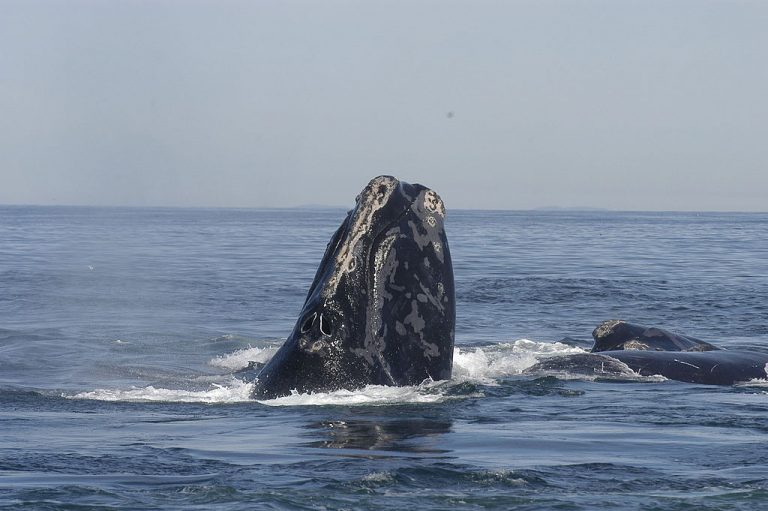
by Deep Green Resistance News Service | Jan 7, 2018 | Biodiversity & Habitat Destruction
Featured image: The critically endangered North Atlantic right whale is a species of utmost concern should seismic airgun blasting be allowed off the Atlantic coast. Photo Credit: Moira Brown and New England Aquarium.
by Mike Gaworecki / Mongabay
The Trump Administration has unveiled its plan to open nearly all of the United States’ coastal waters to oil and gas drilling.
U.S. Secretary of the Interior Ryan Zinke announced the National Outer Continental Shelf Oil and Gas Leasing Program for 2019-2024 yesterday, which includes a proposal to open up more than 90 percent of the country’s continental shelf waters to future exploitation by oil and gas companies. The draft five-year plan also proposes the largest number of offshore oil and gas lease sales in U.S. history.
“Responsibly developing our energy resources on the Outer Continental Shelf in a safe and well-regulated way is important to our economy and energy security, and it provides billions of dollars to fund the conservation of our coastlines, public lands and parks,” said Secretary Zinke. “Today’s announcement lays out the options that are on the table and starts a lengthy and robust public comment period. Just like with mining, not all areas are appropriate for offshore drilling, and we will take that into consideration in the coming weeks.”
The Obama Administration blocked drilling on about 94 percent of the outer continental shelf, but, in April 2017, Trump issued an executive order that called for a review of the 2017-2022 Five Year Outer Continental Shelf Oil and Gas Leasing Program finalized under Obama in favor of implementing Trump’s so-called “America-First Offshore Energy Strategy.”
The draft five-year plan that has just been released by the Trump Administration’s Interior Department would open up 25 of 26 outer continental shelf regions to drilling. The North Aleutian Basin, which lies off the northern shore of the Alaska Peninsula and extends into the Bering Sea, was the only region exempted from drilling in the new plan, the New York Times reports.
The Interior Department proposes to hold 47 lease sales in those 25 regions — including 19 off the coast of Alaska, 12 in the Gulf of Mexico, nine in the Atlantic Region, and seven in the Pacific Region. “This is the largest number of lease sales ever proposed for the National [Outer Continental Shelf] Program’s 5-year lease schedule,” the Interior Department said in a statement.
Earlier moves by the Trump Administration to open the U.S. Atlantic coast to drillinghave already drawn fierce opposition. An alliance of more than 41,000 businesses and 500,000 fishing families from Florida to Maine was joined by fishery management councils for the Mid-Atlantic, New England, and the South Atlantic regions in speaking out against oil exploration and development in the Atlantic. One of their chief concerns is the incredibly disruptive exploration technique known as seismic airgun blasting, which would need to be used to determine how much oil is actually underneath the floor of the Atlantic Ocean off the U.S. East Coast given that oil drilling has been banned there for decades.
Drilling in the Pacific Ocean off the U.S. West Coast has been banned since a 1969 oil spill in Santa Barbara, California. Local officials there also vowed to fight the Trump Administration’s move to open their coastal waters to the oil and gas industry: “For more than 30 years, our shared coastline has been protected from further federal drilling and we’ll do whatever it takes to stop this reckless, short-sighted action,” California Governor Jerry Brown, Oregon Governor Kate Brown, and Washington Governor Jay Inslee said in a joint statement.
Continue reading at Mongabay
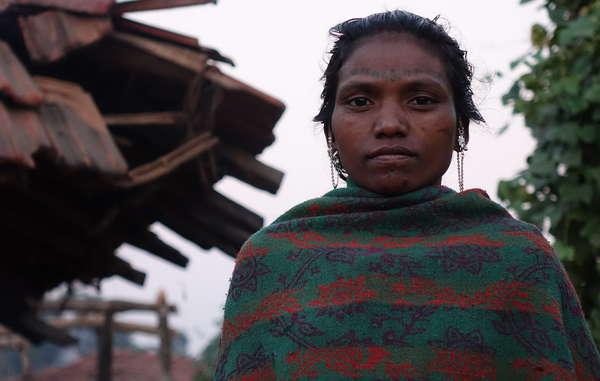
by Deep Green Resistance News Service | Jan 4, 2018 | Colonialism & Conquest
Featured image: This Baiga woman was evicted from Kanha tiger reserve. © Survival International
by Survival International
India’s National Tiger Conservation Authority (NTCA) is coming under increasing pressure over its illegal order banning the recognition of tribal forest rights in tiger reserves. The order prompted Survival International to launch a global tourism boycott in November.
Information released to Survival has revealed that India’s tribal peoples’ Commission (officially called the National Commission for Scheduled Tribes (NCST)) has directly challenged the NTCA’s order in private meetings in Delhi. The Commission demanded that the NTCA suspend any planned evictions of tribal peoples, who have been dependent on and managed their forests for millennia.
After demanding to meet with the NTCA, the Commission argued that the order violates India’s Forest Rights Act – which guarantees tribal peoples’ rights to their forests. It was intended to address the “historical injustice” against tribes and other “traditional forest dwellers.”
In November, representatives of tribal communities met with many human rights and environment activists in Delhi, amidst mounting concern over the NTCA order.
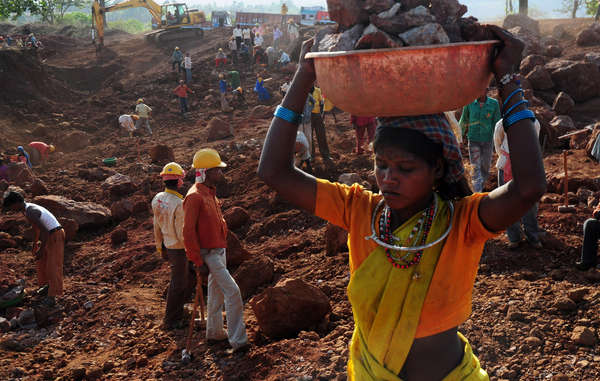
A Baiga woman works for daily wages on Vedanta’s Bodai-Daldali bauxite mine, Chhattisgarh © Sayantan Bera/Survival
J.K. Thimma, a Jenu Keruba man who lives in Nagarhole National Park, and was present at the meeting, said: “The NTCA order is an attack against our culture and our tradition. This is anti-Constitutional and the NTCA have no right to stop the implementation of an Act passed by the Parliament… This is denial for our existence. The order needs to be withdrawn as soon as possible, it is creating fear among all of us.”
Another tribal man, Shankar Barde from Tadoba Tiger Reserve, said: “After years of restrictions and hardships, finally we were told early this year by the district administration that our rights have been recognized. We were excited… but then we were told by the district administration that NTCA order does not allow our rights to be recognized. This is a complete injustice. Dozens of outsiders are earning large sums of money in our backyard while we struggle to even live with dignity.”
Indian law specifically states that the NTCA does not have the power to “interfere with or affect the rights of local people, particularly… tribes.” Tribal rights are under the jurisdiction of the Ministry of Tribal Affairs.
Despite this, conservation authorities have violated the rights of tribal peoples. Across India, tribal peoples endure harassment, coercion, and illegal eviction from their ancestral homelands in the name of conservation.
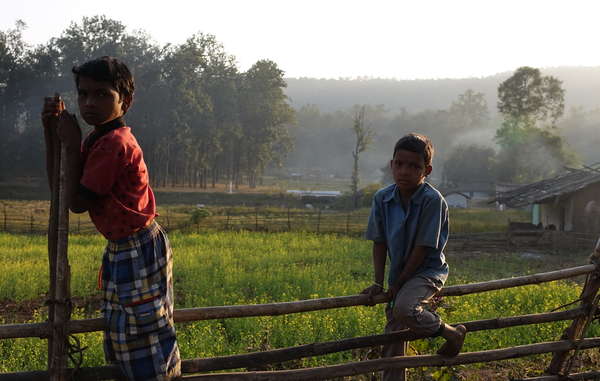
Baiga children. Their village was notified with eviction. Achanakmar Tiger Reserve. © Survival
After eviction, tribal people face lives of poverty and exclusion on the fringes of Indian society. Meanwhile, huge numbers of tourists are then invited into tiger reserves, disrupting tiger habitats and making tigers more vulnerable to poaching.
Survival International is leading the global fight against injustice and abuse in the name of protecting wildlife.
Survival’s Director Stephen Corry said: “This order is an attack on India’s tribal peoples – it’s also illegal. Polluting and destructive industries such as uranium mining and tourism are apparently welcome in tiger reserves, but conservationists in India remain determined to kick tribal people off their land. It’s time they partnered with the best conservationists and guardians of the natural world, and stopped persecuting them. Tribal peoples know their land and its animals better than the conservationists.”
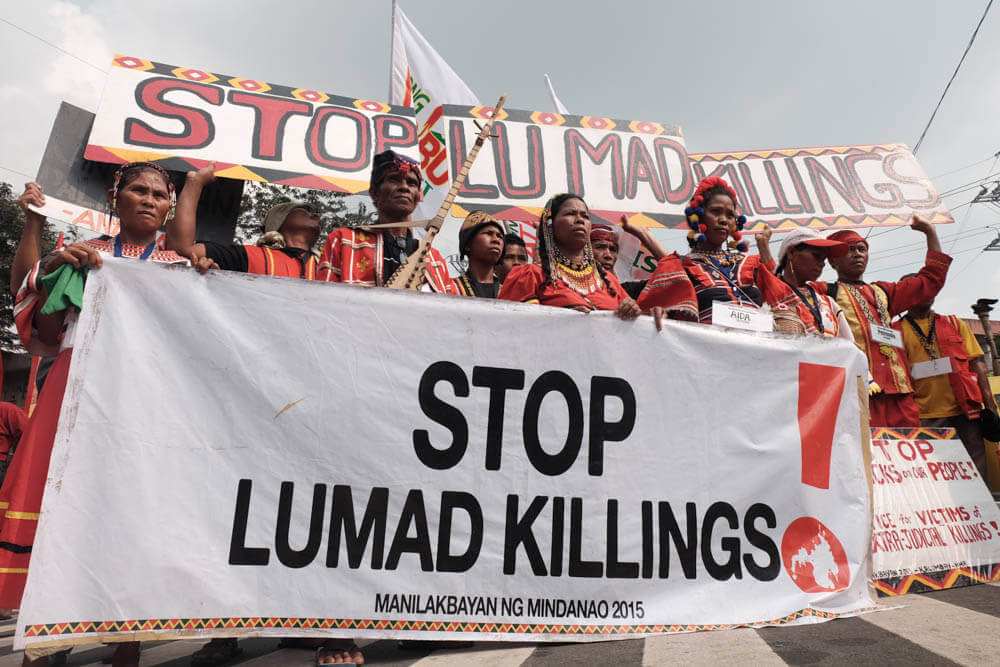
by Deep Green Resistance News Service | Jan 2, 2018 | Colonialism & Conquest
by Pam Tau Lee / Intercontinental Cry
The Lumad are Indigenous Peoples in the southern Mindanao region of the Philippines. The term Lumad is short for Katawhang Lumad (Literally: “indigenous people”), a description officially adopted by delegates of the Lumad Mindanao Peoples Federation founding assembly on June 26, 1986. This grew out of a political awakening among tribes during the martial law regime of President Marcos and reflects the collective identity of 18 Lumad ethnic groups. The assembly’s main objectives was to achieve self-determination and governance for their member-tribes within their ancestral domain in accordance with their culture and customary laws.
The Lumad have a traditional ancestral concept of land ownership which is communal private property. Community members have the right utilize any piece of unoccupied land within the communal territory. Lumad ancestral lands include rain forests, hunting grounds, cultivated and uncultivated land and valuable mineral resources (copper, nickel, gold, chromite, coal, gas, cement) below the land.

For decades the Lumad had been forced to physically defend their right to control their ancestral territories against corporate plunder and militarization. Unable to match up to the armed forces of the government and profiteers the Lumad have had to flee their communities; their land has been seized by multinational corporations and logging companies. Wealthy Filipino migrants and multinationals are planting and exporting palm oil, bananas, rubber and pineapple.
Unequipped to understand the modern land tenure system, the Lumad have established schools in their communities supplying knowledge to young adults and youth on how to protect their rights, property and culture. While these schools have always posed a threat, President Duterte has taken the unprecedented step of directing the Department of Education to close them down and has also encouraged the killing and arrest of Lumad teachers, which continues to go unpunished.
The history of violence and unwarranted (extrajudicial) killings of Lumad at the hands of military, paramilitary, and private security forces is in the hundreds, with the arrest and torture Lumad activists in the thousands. Fifty-six percent of Philippine military have been deployed to the Mindanao region. Today many of the Lumad have sought safety and shelter in evacuation centers where they and other victims of war are crowded into small spaces, lacking sanitary conditions and food, and endure harassment by local police including sexual harassment.
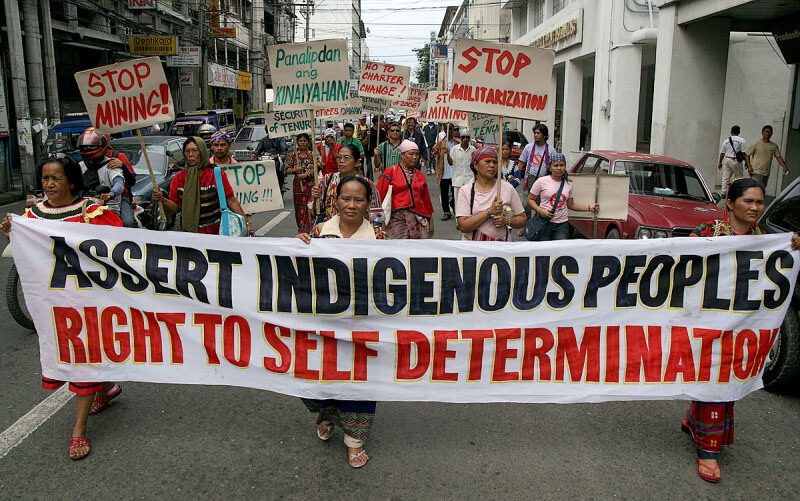
Bolstered by the recent visit of Trump to the Philippines who has promised and delivered increased in military funding to the Philippines, President Duterte has extended martial law on the whole island of Mindanao under the guise of war on terrorism and drugs and has launched a full-scale assault on social justice activists throughout the Philippines, including the Lumad people.
Where there is oppression there is resistance. The Lumad have organized protest actions against mining, extrajudicial killings, and the militarization of their communities, and have led “Manilakbayan” people’s caravans from Mindanao to Manila where they have built unity with Moro and peasant communities and other oppressed sectors in Mindanao and, together, have brought these people’s demands to the national capital. There are some young Lumad that say, because the repression suffered by their community is so bad, at times they consider joining the New Peoples Army. In fact, some Lumad do engage in armed resistance to defend their ancestral lands, as Lumad have done since time immemorial, from fending off logging corporations using spears and native weapons to taking up arms with the New Peoples Army as part of the decades long revolutionary struggle led by the Communist Party of the Philippines. The Lumad struggle continues to take many forms—and as state repression and encroachment on ancestral lands has worsened, Lumad resistance has continued to grow.
In October of 2016, the Lumad people sent messages of solidarity to the tribes and Water Protectors at Standing Rock as they clearly understood the universal common struggle of indigenous to protect the land.

In this moment of intense violence, the International Interfaith Humanitarian Mission 3.0 proposes the following recommendations for the victims of the military operations in Marawi City: Continue relief, medical services and psychosocial intervention for the victims; a just recovery and reparations for homes and properties destroyed; make the Duterte government accountable for the death, displacement of residents and destruction of Warawi City; put people over profit in the rehabilitation of Warawi so that the residents can return to their original communities not profit driven development.
Pam Tau Lee is Chair of the International Coalition for Human Rights in the Philippines (ICHRP) – U.S.
by Deep Green Resistance News Service | Dec 31, 2017 | Repression at Home
Featured image: Protesters at the Dakota Access Pipeline Protest Camp. Image: Michael Nigro/SIPA USA/PA Images. Labeling Native American journalists as “activists” simply because of their heritage helps to further diminish the Indigenous narrative.
by Jenni Monet / openDemocracy
I get approached frequently to discuss my time spent reporting from Standing Rock, the Indigenous-led movement that sought to stop the Dakota Access Pipeline. But what’s funny about these invitations is that they almost always incorporate some notion that I was there as an activist – and without even asking me if that was, indeed, the case.
It’s one of these common assumptions: Native American journalist equals Native American campaigner. To be sure, there are many Indigenous folks I know who call themselves journalists as well as activists in the same breath, and that’s awesome – we need positive and powerful messaging out there. From their headlines, these writers call out today’s problems from tribal community and prompt a call to action. And it works for a lot of different audiences. Indigenous Peoples get a boost, allies get to show their support and outsiders trying to grasp at a world unknown get an introduction to root causes and agendas. Combined, it makes for an easy narrative because of what little critical thinking is required.
But here’s the thing: Indian Country can be a complicated wonder at times, and to routinely simplify the narrative perhaps perpetuates situations like we saw at Standing Rock, where major media presence was uneven at best. It was a stark absence, the lack of journalists on the ground during some of the most critical moments of the movement. It took a harrowing night of police weaponizing water on protesters before major newsrooms ultimately sent crews to the standoff. If it hadn’t been for water protectors themselves live-streaming the episode on Facebook, many would have been led to believe what had been written by the regional Associated Press reporter, who called the sub-freezing night of police-led violence “skirmishes.” But even though citizen journalism corrected where mainstream under-performed, we need to recognize the relationship between the two – and start to scrutinize all newsfeeds that come across our screens.
Since that sub-freezing night of 20 November 2016, we’ve seen an unraveling of documentation proving that the North Dakota police used military-style tactics, guided by a former CIA operative behind the for-hire security firm, TigerSwan. From revelations by DeSmogBlog, The Intercept and other bottom-up revelations, it’s clear that North Dakota police targeted demonstrators, treating them not unlike “jihadists;” they were profiled as “terrorists,” and some were even formally charged with such allegations.
Again, it’s easy to see how a Native American journalist could be seen as an activist with so much stacked up against people demanding clean water.
As I type these words on 4 December 2017, I reflect back to a year ago on this day, when roughly 12,000 people stood in unity on the borderlands of the Standing Rock reservation on the day the Obama Administration called to halt construction of the Dakota Access Pipeline. Those who were there turned out to resist, not just an energy project, but the many other strands of injustices that the months-long demonstration represented: systemic and historic military-led violence, environmental racism, deliberate political marginalization and segregation. The response to these circumstances at Standing Rock was ultimately a resistance to these trends, and also a place for Indigenous Peoples to heal from generations of trauma.
At Standing Rock on this day, 4 December 2016, there were also teams of mainstream journalists literally scrambling to get the story that they had missed for months. I know because I spoke to many of them as they frantically searched for travel directions, quotable sources and facts, so many essential facts. Satellite trucks lined up along Highway 1806, overlooking the sprawling resistance camps. From their perches, reporters went live on the air, quoting Lakota prophecy, and explaining the “black snake,” the symbolic reference that water protectors, or protesters, had called the pipeline.
As the major media parachuted in, predictably, they hired Indigenous “fixers” to get at the story fast and quick; they featured images of the most colorful “Indians” dressed in regalia and face-paint; and they explained treaties and consultation, the cornerstone of these agreements, as if understanding these concepts for the first time – because they were.
But it was bottom-up journalism that helped shape a story that outsiders finally understood from Standing Rock. It’s why when we call Native American journalists “activists” in the same sentence, without thinking otherwise, it automatically diminishes the Indigenous narrative that is already burdened by a chronic, routine ignoring. It’s an injustice in and of itself and something that I often confronted when reporting from Standing Rock, including my own arrest.
On 1 February 2017, I was arrested while gathering interviews and taking photos of a demonstration near the main Oceti Sakowin camp, where water protectors had been camped out in the North Dakota winter. Despite showing my press pass when asked, and leaving the scene when police requested, I was detained for 30 hours, in which five were spent in a freezing garage where I was verbally accosted by the jail captain. I was denied my right to a phone call for more than a day, and while detained I learned that my white cellmates were spared the humiliation of being strip-searched but that Native American women like myself were not. When I was released from jail, I read that police had lied to the Bismarck Tribune about whether I had presented my press pass to officers at the scene of the demonstration. I did, even though they said I did not. Months later, I still face charges of criminal trespassing and engaging in a riot which could result in fines and up to a year in jail.
And so it’s important that we acknowledge that they arrested a journalist that day, on 1 Febuary 2017, not an activist. And it’s important that society respects and sees the difference between the two. My statement is not meant to throw a shade on activism. We need more resistance fighters in this world. It’s just not in my DNA to take to the streets, pump fists and chant politicised slogans. What is in my being is to observe carefully and think critically about these current events shaping our lives and to frame ideas backed by facts that can have the farthest reach with the most integrity.
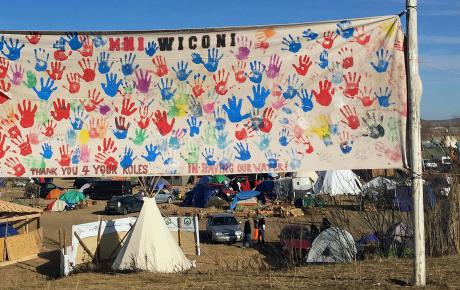
Image: Becker1999 (Paul and Cathy)/Flickr.
We’re living in a day where judicial systems in towns like Mandan, North Dakota, work to discredit journalists by arresting them and labeling them “activists.” These are women like Amy Goodman, an unflappable field reporter and media businesswoman whose work has been recognised around the world. And so to enable this way of thinking isn’t just a disservice to the people who are teetering the fine line between credible narratives and nuance, but it’s a burden to the very democracy that journalism brings and the reason why I believe it is one our noblest professions.
And so as the resistance movement across America spreads, much of it inspired by the people power that came together at Standing Rock, we must also realise that there is a war on journalism happening in America and around the world. Until late November, the mega-chain Wal-Mart was selling a t-shirt that used off-colored humour suggesting hanging journalists. Store executives only agreed to pull the item from its racks following intense scrutiny from the American journalism community. Meantime, according to the U.S. Press Freedom Tracker, there have been reported attacks on at least three dozen journalists in the country alone.
Accountability journalism is becoming one of the most important professions of our time. We must respect this role in this time of resistance, and think twice before using the label “activist.”
Jenni Monet is an award-winning journalist and tribal member of the Pueblo of Laguna in New Mexico. She’s also executive producer and host of the podcast Still Here. @jennimonet
This article was originally published at openDemocracy as a part of Right to Protest, a partnership project with human rights organizations CELS and INCLO, with support from the ACLU, examining the power of protest and its fundamental role in democratic society. It has been re-published at Deep Green Resistance News Service under a Creative Commons License.












